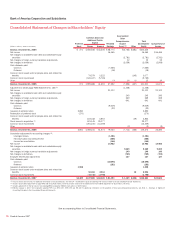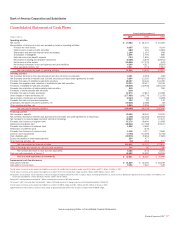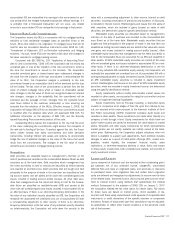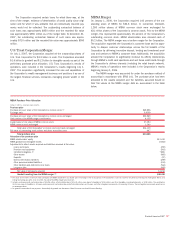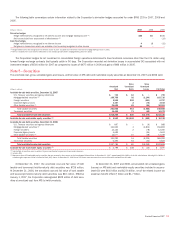Bank of America 2007 Annual Report Download - page 125
Download and view the complete annual report
Please find page 125 of the 2007 Bank of America annual report below. You can navigate through the pages in the report by either clicking on the pages listed below, or by using the keyword search tool below to find specific information within the annual report.Nonperforming Loans and Leases, Charge-offs, and
Delinquencies
In accordance with the Corporation’s policies, non-bankrupt credit card
loans, and open-end unsecured consumer loans are charged off no later
than the end of the month in which the account becomes 180 days past
due. The outstanding balance of real estate secured loans that is in
excess of the property value, less cost to sell, are charged off no later
than the end of the month in which the account becomes 180 days past
due. Personal property secured loans are charged off no later than the end
of the month in which the account becomes 120 days past due. Accounts
in bankruptcy are written down to collateral value either 60 days after
bankruptcy notification (credit card and certain open-end unsecured
accounts) or no later than the end of the month in which the account
becomes 60 days past due. Only real estate secured accounts are gen-
erally placed into nonaccrual status and classified as nonperforming at 90
days past due. These loans may be restored to performing status when all
principal and interest is current and full repayment of the remaining con-
tractual principal and interest is expected, or when the loan otherwise
becomes well-secured and is in the process of collection.
Commercial loans and leases, excluding business card loans, that
are past due 90 days or more as to principal or interest, or where reason-
able doubt exists as to timely collection, including loans that are
individually identified as being impaired, are generally classified as non-
performing unless well-secured and in the process of collection. Loans
whose contractual terms have been restructured in a manner which grants
a concession to a borrower experiencing financial difficulties, without
compensation on restructured loans, are classified as nonperforming until
the loan is performing for an adequate period of time under the
restructured agreement. In situations where the Corporation does not
receive adequate compensation, the restructuring is considered a troubled
debt restructuring. Interest accrued but not collected is reversed when a
commercial loan is classified as nonperforming. Interest collections on
commercial nonperforming loans and leases for which the ultimate
collectibility of principal is uncertain are applied as principal reductions;
otherwise, such collections are credited to income when received. Com-
mercial loans and leases may be restored to performing status when all
principal and interest is current and full repayment of the remaining con-
tractual principal and interest is expected, or when the loan otherwise
becomes well-secured and is in the process of collection. Business card
loans are charged off no later than the end of the month in which the
account becomes 180 days past due or in which 60 days has elapsed
since receipt of notification of bankruptcy filing, whichever comes first, and
are not classified as nonperforming.
The entire balance of a consumer and commercial loan account is
contractually delinquent if the minimum payment is not received by the
specified due date on the customer’s billing statement. Interest and fees
continue to accrue on past due loans until the date the loan goes into
nonaccrual status, if applicable. Delinquency is reported on accruing loans
that are 30 days or more past due.
Loans Held-for-Sale
Loans held-for-sale include residential mortgages, loan syndications, and
to a lesser degree, commercial real estate, consumer finance and other
loans, and are carried at the lower of aggregate cost or market or fair
value. The Corporation elected on January 1, 2007 to account for certain
loans held-for-sale, including first mortgage loans held-for-sale, at fair
value in accordance with SFAS 159. Fair values for loans held-for-sale are
based on quoted market prices, where available, or are determined by
discounting estimated cash flows using interest rates approximating the
Corporation’s current origination rates for similar loans and adjusted to
reflect the inherent credit risk. Mortgage loan origination costs related to
loans held-for-sale for which the Corporation elected the fair value option
are recognized in noninterest expense when incurred. Mortgage loan origi-
nation costs for loans held-for-sale carried at the lower of cost or market
are capitalized as part of the carrying amount of the loans and recognized
as a reduction of mortgage banking income upon the sale of such loans.
Loans held-for-sale are included in other assets.
Premises and Equipment
Premises and equipment are stated at cost less accumulated depreciation
and amortization. Depreciation and amortization are recognized using the
straight-line method over the estimated useful lives of the assets. Esti-
mated lives range up to 40 years for buildings, up to 12 years for furniture
and equipment, and the shorter of lease term or estimated useful life for
leasehold improvements.
Mortgage Servicing Rights
Effective January 1, 2006, the Corporation adopted SFAS No. 156
“Accounting for Servicing of Financial Assets” (SFAS 156) and began
accounting for consumer-related MSRs at fair value with changes in fair
value recorded in mortgage banking income, while commercial-related and
residential reverse mortgage MSRs continue to be accounted for using the
amortization method (i.e., lower of cost or market) with impairment recog-
nized as a reduction to mortgage banking income. Certain derivatives are
used as economic hedges of the MSRs, but are not designated as hedges
under SFAS 133. These derivatives are marked to market and recognized
through mortgage banking income.
Prior to January 1, 2006, the Corporation applied SFAS 133 hedge
accounting for derivative financial instruments that had been designated to
hedge MSRs. The loans underlying the MSRs being hedged were stratified
into pools that possessed similar interest rate and prepayment risk
exposures. The Corporation had designated the hedged risk as the change
in the overall fair value of these stratified pools within a daily hedge peri-
od. The Corporation performed both prospective and retrospective hedge
effectiveness evaluations, using regression analyses. A prospective test
was performed to determine whether the hedge was expected to be highly
effective at the inception of the hedge. A retrospective test was performed
at the end of the daily hedge period to determine whether the hedge was
actually effective. Debt securities were also used as economic hedges of
MSRs and were accounted for as AFS securities with realized gains or
losses recorded in gains (losses) on sales of debt securities and unreal-
ized gains or losses recorded in accumulated OCI in shareholders’ equity.
For additional information on MSRs, see Note 21 – Mortgage Servicing
Rights to the Consolidated Financial Statements.
Goodwill and Intangible Assets
Assets and liabilities of companies acquired in purchase transactions are
recorded at fair value at the dates of acquisition. Goodwill is not amortized
but is reviewed for potential impairment on an annual basis, or when
events or circumstances indicate a potential impairment, at the reporting
unit level. The impairment test is performed in two phases. The first step
of the goodwill impairment test compares the fair value of the reporting
unit with its carrying amount, including goodwill. If the fair value of the
reporting unit exceeds its carrying amount, goodwill of the reporting unit is
considered not impaired; however, if the carrying amount of the reporting
unit exceeds its fair value, an additional step has to be performed. This
additional step compares the implied fair value of the reporting unit’s
goodwill (as defined in SFAS No. 142, “Goodwill and Other Intangible
Bank of America 2007
123





